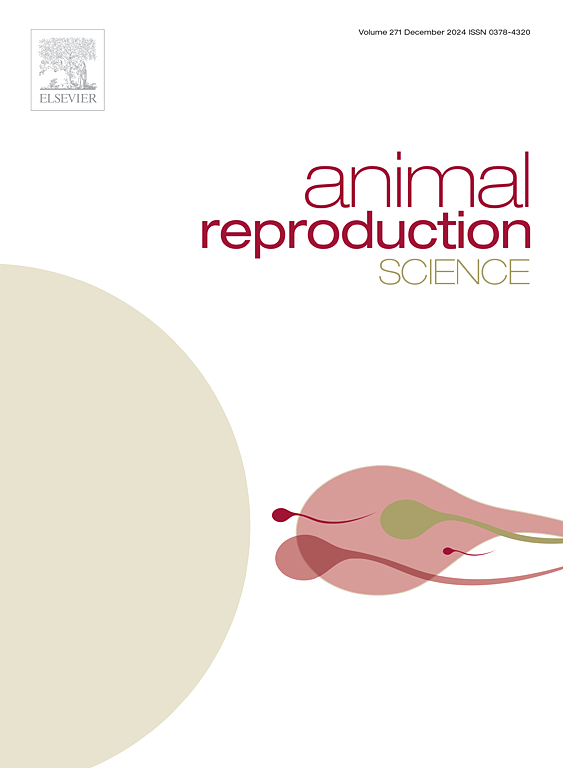Mitoquinone mesylate promotes oocyte maturation and subsequent embryonic development by regulating oxidative stress in Tibetan sheep
IF 2.2
2区 农林科学
Q1 AGRICULTURE, DAIRY & ANIMAL SCIENCE
引用次数: 0
Abstract
In vitro maturation (IVM) is a very important technology for the modernization of animal husbandry. Previous studies have demonstrated that the mitochondria-targeting antioxidant mitoquinone mesylate (MitoQ) was known for its protective role in a variety of tissues and cells; however, its function in Tibetan sheep oocytes is not fully understood. This study used a Tibetan sheep model to evaluate the effects of oocytes exposed to MitoQ on maturation and subsequent embryonic development. During IVM, cumulus-oocyte-complexes were exposed to 0–400 nM MitoQ to evaluate the viability of cumulus cells expansion and oocyte maturation, and determine the optimal concentration of 100 nM. Here, we discovered that 100 nM MitoQ addition to the medium improved the Tibetan sheep oocyte maturation rate (P < 0.05) and cumulus cells expansion rate (P > 0.05). In addition, immunostaining showed that decreased ROS levels (P < 0.01), increased GSH levels (P < 0.01). MitoQ-treated oocytes showed enhanced mitochondrial activity (P < 0.01) and mitochondrial membrane potential (P < 0.05). MitoQ increased Ca2 + levels (P < 0.01) and attenuated early apoptosis (P < 0.01). No differences were observed for cleavage rate (P > 0.05), and improved number of blastocyst cells and the blastocyst rate (P < 0.05) after in vitro fertilization. Moreover, various genes associated with oocyte oxidative stress (GCLC, SOD1) in mature oocytes were beneficially regulated in the MitoQ-treated oocytes. In conclusion, MitoQ can enhance the oocyte maturation rate, improve subsequent embryonic development in Tibetan sheep.
甲磺酸米托醌通过调节氧化应激促进藏羊卵母细胞成熟和胚胎发育
体外成熟技术是实现畜牧业现代化的一项重要技术。先前的研究表明,线粒体靶向抗氧化剂甲磺酸米托醌(MitoQ)在多种组织和细胞中具有保护作用;然而,其在藏羊卵母细胞中的功能尚不完全清楚。本研究使用藏羊模型来评估暴露于MitoQ的卵母细胞对成熟和随后胚胎发育的影响。在IVM期间,将积云卵母细胞复合物暴露于0-400 nM的MitoQ中,以评估积云细胞扩增和卵母细胞成熟的活力,并确定100 nM的最佳浓度。我们发现,在培养基中添加100 nM MitoQ可提高藏羊卵母细胞成熟率(P <; 0.05)和积云细胞扩增率(P >; 0.05)。此外,免疫染色显示ROS水平降低(P <; 0.01),GSH水平升高(P <; 0.01)。经mitoq处理的卵母细胞线粒体活性(P <; 0.01)和线粒体膜电位(P <; 0.05)增强。MitoQ增加Ca2 +水平(P <; 0.01),减少早期细胞凋亡(P <; 0.01)。体外受精后的卵裂率(P >; 0.05)、囊胚细胞数和囊胚率(P <; 0.05)均无显著差异。此外,成熟卵母细胞中与卵母细胞氧化应激相关的各种基因(GCLC, SOD1)在mitoq处理的卵母细胞中得到有益的调节。综上所述,MitoQ能提高藏羊卵母细胞成熟率,改善后续胚胎发育。
本文章由计算机程序翻译,如有差异,请以英文原文为准。
求助全文
约1分钟内获得全文
求助全文
来源期刊

Animal Reproduction Science
农林科学-奶制品与动物科学
CiteScore
4.50
自引率
9.10%
发文量
136
审稿时长
54 days
期刊介绍:
Animal Reproduction Science publishes results from studies relating to reproduction and fertility in animals. This includes both fundamental research and applied studies, including management practices that increase our understanding of the biology and manipulation of reproduction. Manuscripts should go into depth in the mechanisms involved in the research reported, rather than a give a mere description of findings. The focus is on animals that are useful to humans including food- and fibre-producing; companion/recreational; captive; and endangered species including zoo animals, but excluding laboratory animals unless the results of the study provide new information that impacts the basic understanding of the biology or manipulation of reproduction.
The journal''s scope includes the study of reproductive physiology and endocrinology, reproductive cycles, natural and artificial control of reproduction, preservation and use of gametes and embryos, pregnancy and parturition, infertility and sterility, diagnostic and therapeutic techniques.
The Editorial Board of Animal Reproduction Science has decided not to publish papers in which there is an exclusive examination of the in vitro development of oocytes and embryos; however, there will be consideration of papers that include in vitro studies where the source of the oocytes and/or development of the embryos beyond the blastocyst stage is part of the experimental design.
 求助内容:
求助内容: 应助结果提醒方式:
应助结果提醒方式:


